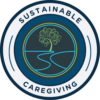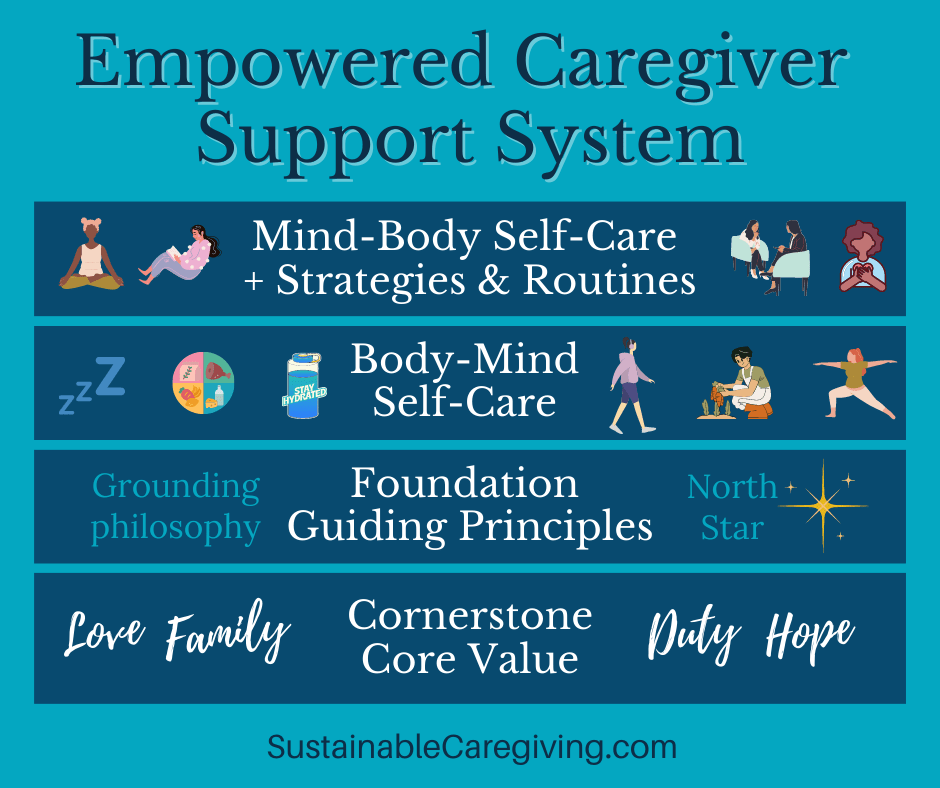When we experience a significant life change, our support network often changes. Therefore, it isn’t surprising that we will want to rethink and recreate our support system when we step or fall headfirst into a caregiving role. When we think of a support system, we often think of people. While people can be an essential part of our caregiver support system, we need a more varied and versatile system that doesn’t solely rely on the physical and emotional availability of others.
Creating a support system of strategies, self-care activities, and routines to prioritize well-being will empower us. Our support system will help prevent burnout. We will reimagine and regain control of our emotions and the chaos we often feel when caring for a family member.
Imagine your caregiving journey is like being in a raft on a river. The river has calm sections, obstacles, rapids, and a few waterfalls. At times, we feel like we’ve been tossed out of the raft and are drowning. When we employ certain strategies to protect our well-being and manage the emotions and the stress, the river doesn’t change. How we navigate the river changes. We step into the flow.
Our Fragile Caregiver Ecosystem
A caregiver support system integrates our values with the activities that support those values. Our support system sustains us as we navigate our caregiving journey for the duration of the experience and beyond. Just like rivers are managed with dams, riverbank reinforcements, and reservoirs to support irrigation and prevent flooding, erosion, and sediment build-up, we can control our environment by establishing a system of protections that supports our fragile caregiving ecosystem.
The strategies and activities combine to strengthen and support each other and us. When they can adapt to our ever-evolving circumstances, they become a stable and solid yet fluid support system. Our support system helps us manage our fragile caregiving ecosystem. The river is ever-changing, and our support system must evolve to match the changing current and the emerging obstacles.
“It is not the load that breaks you down. It’s the way you carry it.”
Lena Horne
Our support system helps us carry our caregiving load in a way that is sustainable so that we can prioritize our well-being while caring for our family member. Not an easy feat.
Varied and Versatile Network
A caregiver support system is a network of activities, strategies, and routines that sustain us as we navigate our caregiving journey for the duration of the experience and beyond. Our support system integrates our values with the activities that support those values. When we think of a support system, we often think of people. While people can be an essential part of our caregiver support system, we need a more varied and versatile system that doesn’t solely rely on the physical and emotional availability of others.
Foundation and Cornerstone
The foundation of our support system is the grounding philosophy that provides strength, stability, and direction. Our values form our foundation and guide our thoughts and actions. Our values may be rooted in our upbringing and family values or may be grounded in a philosophy, spiritual source, or a combination of sources. We can think of our foundation as our north star, our internal GPS, that provides direction when we feel lost.
The cornerstone, our core value, is the heart, the key to how our system fits together. It is the first stone set in a foundation, and all other stones are placed in reference to the cornerstone. With reflection, we can identify our core values and recognize the power of our foundation’s core which is where we get our strength. Our cornerstone value provides hope when we feel hopeless. It could be love, determination, family, hope, obligation, or another core value.
Body-mind self-care
The next layer in our support system is physical self-care with a focus on the body, which also benefits our mind. Sleep, nutrition, hydration, and movement are critical to our well-being and support system. It is also essential to schedule and attend annual wellness visits. Keep those dentist appointments and other important sessions that help us remain healthy. Without adequate attention to our physical well-being, we will not have the energy or capacity to care for ourselves in a way that sustains us while we care for our family member. Prioritizing physical self-care is how we sustain the energy to create the next support layer in our system. A complete support system is how we not only survive but thrive in our caregiving role. We will feel confident and capable as caregivers and as we deal with all of life’s challenges.
Sleep
When we sleep well, our thinking is more precise, we are less susceptible to mental and physical illnesses, and we can better tolerate incidents that cause frustration.
Nutrition
It is important to eat regularly and with intention, choosing from healthy options so that our brains and bodies are fueled and functioning at optimum levels to make those difficult decisions.
Hydration
Staying hydrated is equally important. When we are dehydrated, the levels of the stress hormone cortisol increase in our bodies. Whereas being adequately hydrated reduces our stress levels. In addition to our minds being stressed, when we are dehydrated, our body is stressed and not optimally supporting us.
Exercise
Next is exercise or some type of movement. Movement has been connected to many physical and mental health benefits, including increased energy levels, improved mood, better sleep, and increased feelings of confidence and control. Regular exercise has proven to offer long-term anxiety prevention benefits. Any form of movement can enhance mood, including exercise, yoga, dance, tai chi, paddling, and more.
Movement gets our blood flowing, delivering nutrients and oxygen to our organs and removing built-up toxins. There is also a mindfulness benefit. We can enter a flow state when we move our bodies and get lost in the rhythm of gardening, walking, yoga, and dance. We can also incorporate a social aspect to movement by joining a hiking club or attending fitness classes at a gym. Another benefit is that movement allows us to exert pent-up energy and release happy hormones.
Mind-body self-care
The next level of our support system sets us up to thrive in our role. This part of our system includes a combination of self-care activities and strategies that support our emotional, mental, and spiritual well-being. These practices, consequently, improve our physical state. With trial and error, we learn how to incorporate well-being activities into routines. Activities and routines can be modified to seamlessly exist within our caregiving reality. Strategies such as setting boundaries, finding effective methods to release frustrations, and micro-dosing self-care throughout the day empower us as we confidently continue our journey.
These self-care activities evolve with our situation, circumstances, and needs. They help us navigate change, process the caregiving experience, and generate internal growth. These components weave through daily activities and change the color, the flow, and the intensity of the experience. It is the fluidity that provides stability.
Emotional, social, and mental self-care
Consider, for example, journaling, an emotional self-care practice, and meditation, a spiritual self-care practice. Each activity helps us manage the storm of emotions, and they can work together; Meditation creates space for clarity from journaling.
Learning and planning are mental self-care practices that we can schedule into our routines. Our circumstances are ever-evolving, and when our understanding and solutions can evolve at a similar pace, we don’t feel swept away by the rapid changes. We can learn from websites, books, blogs, guides, and courses.
Connecting with others for social interaction also allows us to vent our frustrations. Venting can be incorporated into our support system. Venting is an activity that combines social and emotional self-care.
Spiritual self-care
A spiritual practice helps us cope and leads to growth. If our foundation is rooted in a belief system that includes prayer, prayer becomes a key component and an activity to prioritize. It may be that we spend time in nature.
“Look deep into nature, and then you will understand everything better.”
Albert Einstein
Or our spiritual practice might be to meditate or devote moments to stillness. Meditation is a powerful mindfulness practice that cultivates peace by unburdening our minds as described by Georg Feuerstein, “A form of centering, which involves our disengagement from the machine of our mind and our resting in the heart.”
Safe space for self-care
In addition, expressing our creativity through art or cooking, listening to music, or knitting, for example, are activities that help us relax, flow from the present moment, tune out our worries, and tune into ourselves. We can practice self-care in a safe space we have created in our home or our care recipient’s home or find a special space outdoors or at a library or coffee shop.
In whatever way we choose to connect with our inner-self and outer-essence, or the ways in which we learn and experience growth, our methods and practices can be incorporated into our routines and protected with boundaries. Awareness helps us tailor our support system to our needs and circumstances. We can add, adjust, and remove activities to and from routines as required. Because challenges and needs are fluid and change daily, sometimes hourly, strategies and solutions must be fluid. What works one day to manage stress or circumstances doesn’t always work the next day.
Construct your system
To construct your system, determine what components and strategies will help you stay afloat. Which practices keep you moving confidently through the rapids toward calm waters. Which self-care activities calm the inner storms? Trial and error are a necessary part of this process as you establish routines and assemble your caregiver support system. Consider setting aside rather than discarding the strategies that do not currently serve you because they may fit your needs in the future.
For more information on the 12 Sustainable Caregiving Strategies that will strengthen your caregiver support system, check out Navigating the Caregiver River: A Journey to Sustainable Caregiving and the Self-Caregiving Strategies Podcast.
Schedule Theresa Wilbanks to speak on caregiving and empower the caregivers in your workplace or community with the 12 Sustainable Caregiving Strategies.
Advice offered is for general information only; please contact your healthcare team, legal or financial advisors to guide your particular situation.


Pingback: 6 Types of Caregiver Self-Care - Sustainable Caregiving™
Pingback: Essential Guide to Setting Healthy Boundaries as a Caregiver - Ree Writes - African American female UX writer, health writer, and technical writer in Hampton Roads